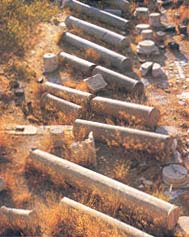How to Recognize an Earthquake
Sidebar to: Earthquake!
The rumbling and shaking may have stopped 3,000 years ago, but it’s often still possible to determine whether an earthquake caused it. Although the damage depends on many factors—including the magnitude of the quake; the location, materials, construction and design of the affected buildings; and the nature of the underlying rock or soil—there are several telltale signs to look for:
Neat rows of fallen columns

In ancient public buildings, freestanding columns are unsecured at the base and usually support only light roofs. When an earthquake hits, the columns fall in the direction of the ground motion caused by a quake. At Sussita (in Greek, Hippos), on the eastern shore of the Sea of Galilee, marble and granite columns (above) lie in a row beside their bases, which remain standing on the floor of a church that collapsed in an earthquake in 749 C.E.
Already a library member? Log in here.
Institution user? Log in with your IP address.

